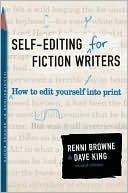More on this book
Community
Kindle Notes & Highlights
by
Renni Browne
Read between
March 10 - March 16, 2025
You can also join a writers group and have other writers critique your manuscript. Unfortunately, writing groups can sometimes do more harm than good. Writing and editing are two different skills, and even strong writers can make poor editors. Many of these group critiques will teach you to write the book your critiquers want you to write, when you want to learn to write the book you want to write.
To write exposition at length—describing your characters’ pasts or events that happened before the story began or any information your readers might need to understand your plot—is to engage your readers’ intellects. What you want to do is to engage their emotions.
But telling your readers about your characters’ emotions is not the best way to get your readers involved. Far better to show why your characters feel the way they do.
You don’t want to give your readers information. You want to give them experiences.
So when you come across an explanation of a character’s emotion, simply cut the explanation. If the emotion is still shown, then the explanation wasn’t needed. If the emotion isn’t shown, rewrite the passage so that it is.
It’s often a good idea to introduce a new character with enough physical description for your readers to picture him or her. As with describing your settings, all you need are a few concrete, idiomatic details to jump-start your readers’ imaginations (“A good-looking man in his fifties,” for instance, is too vague to be interesting). But when it comes to your characters’ personalities, it’s much more engaging to have these emerge from character action, reaction, interior monologue, and dialogue than from description.
Another unobtrusive way to develop a character is to write not about the character directly but about other matters from that character’s viewpoint. This amounts to your giving us your character’s views of the world rather than your views of your character.
When you present your readers with already-arrived-at conclusions about your characters, you leave your readers with nothing to do, and passive readers are at best unengaged and at worst bored. You need to let your readers take an active role in the writer-reader partnership to draw them into your story.
It takes a lot of self-confidence to drop readers into the middle of the trial of a star god by a council of his peers and leave so much unexplained—readers never see the hall of blue trees again, for instance, and we don’t learn what a Zoi is until near the end of the novel. And yet, this approach works, in part because the emotions are so powerful that readers are drawn into the story despite the unanswered questions. Indeed, finding the answers is one of the things that keeps readers reading. Also, by never explaining her situations, by trusting her readers to keep up with her, Jones pays
...more
So be on the lookout for paragraphs that run more than, say, a half-page in length. Whether it’s because readers feel lectured to, or because they feel crowded, or simply because some white space on the page is visually inviting, lengthy unbroken chunks of written material are off-putting. The simple, purely mechanical change of paragraphing more frequently can make your writing much more engaging.


